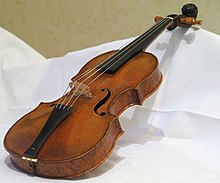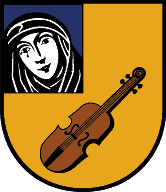Jakob Stainer


Jakob Stainer (also Jacob or Jacobus ; * 1619 in Absam ; † October or November 1683 there ) was a Tyrolean violin maker.
Life
Stainer was the son of a miner . He received his training from 1626 to 1630, possibly also Latin lessons from the schoolmaster of Absam. His later letters and his writing suggest a good education and Italian language skills. Possibly he was a choirboy in the aristocratic women's monastery in Hall in Tirol and at the Innsbruck court. He presumably completed an apprenticeship as a carpenter during this time. If they were not the sons of masters, violin maker apprentices had to have completed an apprenticeship as a carpenter.
Jakob Stainer was trained as a violin maker between 1630 and 1644. Innsbruck and Füssen are ruled out as training centers because of unrest caused by the Thirty Years' War . Stainer apparently received his training in Italy, probably in Venice . In addition to the five years of apprenticeship, there were a few years of traveling. Some evidence suggests that part of this may have been in Amati's workshop in Cremona.
From 1644 Stainer began his independent career as a violin maker. He sold his instruments to monasteries and courts in Salzburg, Innsbruck, Munich, Venice, Kirchdorf, Bozen, Nuremberg, Kremsier and Meran. He did not take on apprentices, so that his art of violin making was not passed on.
On November 26, 1645, Stainer married Margareta Holzhammer in Absam. From then on he worked as a violin maker mainly in Absam, but was often on the road either to sell violins or to buy materials. In 1646 he delivered seven instruments to the Innsbruck court. A year later he stayed in Kirchdorf (Upper Austria) and left debts, which led to a court hearing in 1667. Stainer worked as alto and assistant to the parish choir in Merano in 1649, three years later he received another commission for the Innsbruck court.
In 1656, Stainer became the owner of a house in Absamer Oberdorf (today the "Stainer House"). Two years later, Archduke Ferdinand Karl awarded him the title of "Archduke's Servant", which expired with the Archduke's death in 1662; From Emperor Leopold I in 1669 he received the title of "Imperial Servant".
In 1668 a dispute began with the church authorities over the possession of "heretical bicher". Stainer was summoned to Brixen, the seat of the prince-bishop. Since he did not appear, a house search and secret inquisition were ordered. A year later Stainer had to be arrested in Innsbruck because of "worried escape". From 1670 to 1679 he received orders from Meran, Salzburg, Schwaz, Munich and Nuremberg.
From 1680 Stainer suffered increasingly from depression. In late October or early November 1683 he died in Absam - according to the latest research not impoverished, but wealthy - but mentally deranged.
Honors
In 1942 Jakob-Stainer-Gasse in Vienna- Hietzing was named after him. In Innsbruck and Absam, too, a street in Stainerstrasse commemorates the violin maker, and his home community has also included a violin in his coat of arms in his honor.
Stainer's instruments
Stainer's instruments differ significantly from the architectural style in Brescia, but not fundamentally from the structural features of the Cremonic Amati period. In general, the following differences are stated compared to Cremona:
- High curvature of the ceiling and floor - wider and shorter format.
- While the curvature of the floor rises continuously in the longitudinal direction towards the center, the ceiling is designed to be more like a plateau.
- It is worth mentioning the elaboration of the panels (top and bottom): due to the high curvature, Stainer keeps the top thicknesses as thick as possible from top to bottom in order to absorb the string tension in the longitudinal direction. In contrast, the concept in Cremonese violin making after 1700 ( A. Stradivari , Guarneri del Gesù ) provides for the "sound center" (in the area of the bridge, the ff holes) to be left thickest with a relatively flatter curve.
- In terms of style, Stainer is closer to Amati than to the Cremonese violin makers of the 18th century.
- Vertical ff-holes, delicate and short, the lower ends ending in circular holes
- the snails curled wide and arched
Instrument deliveries
Some proven instrument deliveries from Stainers:
| 1644 | 1 viola bastarda for the prince-bishop's court music band to Salzburg; 4 instruments for Marienberg Monastery (South Tyrol) |
| 1645 | 1 bass viola to Munich |
| 1646 | 7 instruments to the Innsbruck court |
| 1648 | Orders from the parish church of Bolzano |
| 1650 | 1 violoncello to the court orchestra of Köthen |
| 1668 | 1 violone to the court of Kremsier |
| 1669 | Lambach Abbey orders 10 instruments; Kremsier 6 instruments, including a large violone |
| 1670-72 | 5 instruments for court music in Salzburg |
| 1674 | Order for Merano, 1 violin for Salzburg |
| 1677 | 2 violins for the St. Georgenberg monastery in Fiecht |
| 1678 | 1 viola da gamba to Merano |
| 1679 | Orders for the court in Munich |
| 1680 | Follow-up orders for Munich, 3 instruments to Nuremberg |
Traditional
- In Francesco Maria Veracini's estate from 1715, 26 musical instruments are mentioned, including 10 violins by Stainer. His two favorite stainers were lost in a shipwreck in the English Channel in 1746.
- Heinrich Ignaz Franz Biber had personal contact with Stainer.
- Francesco Geminiani played on a Stainer.
- Giuseppe Tartini sometimes played on a Stainer.
- A monastery exchanged a goblet worth 100 ducats for a Stainer violin.
- From JS Bach Orchestra is recorded that they played music on several Tyrolean violins and cellos.
- In the 18th century, Stainer violins were sold at a much higher price than "Cremonese" violins ( Amatis or Stradivaris ).
Stainer "copies"
Stainer used both handwritten and printed notes , but after 1665 only handwritten ones. As early as the 18th century it was common practice in Mittenwald to label instruments made there with “Stainer” labels. In most cases these contain the inscription "Jacobus Stainer Absam prope Oenipontum 16 .." (German: Jacobus Stainer from Absam near Innsbruck). Since the date of Stainer's death was not known at that time, “real” Stainer violins were dated to 1712. In the late 19th and early 20th centuries, tens of thousands of cheap student instruments, mainly from Saxon manufacturers, were made into "stainers". Printers immediately offered the reprinted notes for sale in sheets. In this way, along with Stradivari and Amati, Stainer was one of the most productive and plagiarized violin makers in history, apparently beyond their death.
Touristic
- The Tyrolean State Museum Ferdinandeum in Innsbruck is the only one to own a complete quintet by the local master violin maker.
- An original instrument is in the Stainer exhibition in the new village museum in Absam.
literature
- Christoph Brandhuber: Stainer, Jakob. In: Biographisch-Bibliographisches Kirchenlexikon (BBKL). Volume 28, Bautz, Nordhausen 2007, ISBN 978-3-88309-413-7 , Sp. 1457-1474.
- Franz Farga: violins and violinists. 2nd, unchanged edition. Albert Müller Verlag, Zurich 1940.
- Rudolf Hopfner, Wilfried Seipel : Jacob Stainer. "... imperial servant and violin maker in Absom"; an exhibition at the Kunsthistorisches Museum Wien; Ambras Castle, June 4 to October 31, 2003 . Kunsthistorisches Museum Wien , 2003, ISBN 3-85497-060-9 .
- Heinrich Noë : A home of German hard work . In: The Gazebo . Issue 1, 1873, pp. 9–11 ( full text [ Wikisource ]).
- Walter Senn: Jakob Stainer - the violin maker at Absam. The life story according to documentary sources (= Schlern writings. Volume 87). Wagner University Press, Innsbruck 1951.
- Walter Senn: Absam Jakob Stainer's violin maker. In: Österreichische Musikzeitschrift , Volume 25, 1970, pp. 680 ff.
- Walter Senn, Karl Roy: Jakob Stainer. Life and work of the Tyrolean master 1617–1683 (= The musical instrument. Volume 44). Bochinsky, Frankfurt / M. 1986, ISBN 3-923639-69-4 .
- Erich Tremmel: Stainer, Jacob. In: Oesterreichisches Musiklexikon . Online edition, Vienna 2002 ff., ISBN 3-7001-3077-5 ; Print edition: Volume 5, Verlag der Österreichischen Akademie der Wissenschaften, Vienna 2006, ISBN 3-7001-3067-8 .
- Wilhelm Joseph von Wasielewski : Stainer, Jacobus . In: Allgemeine Deutsche Biographie (ADB). Volume 35, Duncker & Humblot, Leipzig 1893, p. 413 f.
- Constantin von Wurzbach : Stainer, Jacob . In: Biographisches Lexikon des Kaiserthums Oesterreich . 37th part. Kaiserlich-Königliche Hof- und Staatsdruckerei, Vienna 1878, pp. 97–99 ( digitized version ).
Web links
- Jakob Stainer - the wanderer. A violin maker in the age of doubt
- jakob-stainer.de Website of Heinz Peller with biographical data of Stainer, list of instruments, list of literature and recordings on which Stainer instruments can be heard
- Collection of four Stainer instruments from the Musikkollegium Winterthur
Museums
- Stainer exhibition in the village museum in Absam
- Jakob Stainer: "Father of the German violin" with information on eight Stainer instruments in the Tyrolean State Museum , Innsbruck
- Violin and viola in the National Music Museum, Vermillion, South Dakota, USA
- Four Stainer instruments in the Kunsthistorisches Museum , Vienna
Remarks
- ↑ In a more recent study on the website of Jakob Stainer's life and work www.jakob-stainer.de, the author comes to the conclusion, after considering all the relevant and currently known data, that a year of birth from late 1619 to early 1620 is likely. Since his brother Martin was baptized on October 25, 1618, Jakob Stainer's birth in 1618 is hardly possible. Detailed information can be found in the article Comments on Jakob Stainer's year of birth ( memento of the original dated November 27, 2015 in the Internet Archive ) Info: The archive link was automatically inserted and not yet checked. Please check the original and archive link according to the instructions and then remove this notice. .
| personal data | |
|---|---|
| SURNAME | Stainer, Jakob |
| ALTERNATIVE NAMES | Stainer, Jakobus; Stainer, Jacobus |
| BRIEF DESCRIPTION | Tyrolean violin maker |
| DATE OF BIRTH | after September 1618 |
| PLACE OF BIRTH | Absam |
| DATE OF DEATH | October 1683 or November 1683 |
| Place of death | Absam |



